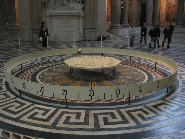
As a physics and philosophy dual concentrator, Emi Birch ’14 has taken an interdisciplinary approach to her education, an approach that is also reflected by her summer research project. Birch is attempting to replicate an experiment conducted by French physicist Jean Foucault in 1851. Foucault hung a 67 meter (about 220 ft.) pendulum from the roof of the Pantheon, in Paris, in order to demonstrate the rotation of the earth. The experiment was widely popular and often drew crowds and was soon replicated in cities across Europe. Foucault’s pendulum is still featured in many museums today.
Because Birch and her faculty advisors, Director of Laboratories and Lecturer in Physics James Schreve and Associate Professor of Physics Seth Major, were unable to find a suitable location in the Taylor Science Center to replicate Foucault’s pendulum on a large scale (specific flawless geometrical angles are needed), they will be constructing a smaller scale pendulum which will stand at 3 meters tall (about 10 ft.). Birch and her team will have to be careful to avoid elliptical motion precession, or unwanted changes in the direction of the rotational axis, to which smaller pendulums are more susceptible.
Birch’s experiment will be based primarily on research done by physicists M.G. Olsson, A. Reinhardt and Richard Crane; however, there is a vast body of research on Foucault’s pendulum that Birch will also be referencing. Birch’s ultimate goal is to synthesize historical and modern attempts to recreate Foucault’s pendulum in order to build the most perfect example of a pendulum that eliminates the problems experienced in both historical and modern past attempts.
Birch’s research first unfolded more like a history project than a physics one. She pored over numerous past experiments to replicate Foucault’s pendulum, documenting the minute flaws and successes of past attempts. According to Birch, it was “most apparent [to the team] in research that most builders only focused on certain problems while neglecting others,” and that “over an extended period of time, [Birch and her team] can address all of these problems, creating a more well rounded solution.” Upon concluding her research, Birch moved on to construct the pendulum itself with the help of her faculty advisors and the Taylor Science Center’s shop technicians and machinists.
Birch’s goal for the summer is to construct the pendulum’s drive mechanism and mount, with the rest of the pendulum being constructed during future research projects. The drive mechanism is responsible for preventing the pendulum’s motion from dying out. It is comprised of an electromagnet – a large spindle wrapped more than 3,000 times with wire – connected to a circuit board which relays pulses to drive the flow of current. The pendulum’s mount needs to be as symmetrical as possible, as asymmetries will cause the aforementioned side effect of elliptical motion precession. The pendulum’s mount will be based on Birch’s synthesis of past Foucault pendulum successes.
Birch is interested in pursuing a career in experimental physics; however, she remarked that, regardless of her career path, “this research is giving me the invaluable skills that would help in any job, skills like finding creative solutions to preexisting problems and synthesizing the work of others to find the best course of action.” Birch is a member of the Hamilton women’s varsity soccer team and enjoys hiking in the Adirondacks and slack lining, a rope balancing sport.
Emi Birch is a graduate of Steamboat Springs High School (Colo.)
